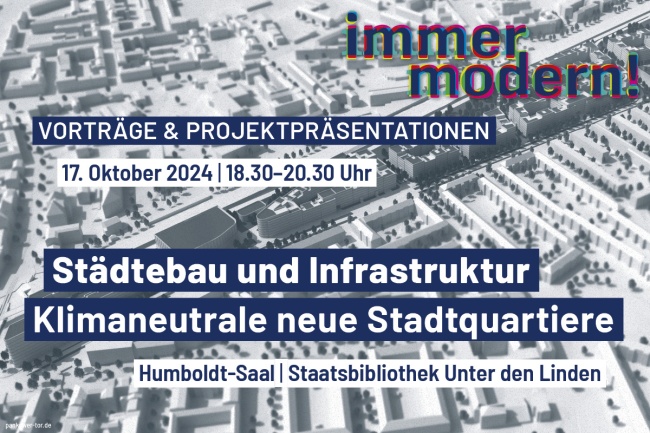17 Oct 24 // Lecture
Urban development and infrastructure
Climate-neutral new city districts

The Behrens-Ufer on the Spree in Oberschöneweide, the Neue Gartenfeld in Spandau or the ‘Pankower Tor’. Over the next few years, new residential and commercial neighbourhoods will be built in numerous locations in Berlin, changing the face of the city and creating urgently needed new living space. Against the backdrop of the climate, heat and traffic crisis, however, neighbourhood developments in these locations need to be rethought and reorganised.
This includes, among other things, transport concepts that provide close links to public transport and avoid individual car traffic in the neighbourhood. This also includes technologies that generate energy primarily from local sources and create local heating networks.
The event asked: How can climate-neutral urban neighbourhoods be built? What role does sustainable urban development play? What approaches are there for innovative mobility concepts? How will Berlin's heating and power supply infrastructure be modernised in the coming decades?
Programme
Thu, 17. Oct 2024
Start of the event
Moderation
Rudolf Spindler
Greeting
Prof. Dr. Harald Bodenschatz
Chairman of the Architects‘ and Engineers’ Association of Berlin-Brandenburg
Introduction
Lars Loebner
Head of Division at the Senate Department for Urban Development, Building and Housing Berlin
Department II Housing Projects - Outer City
How will Berlin's heating and power supply infrastructure be modernised in the coming decades?
Georg Friedrichs
Chairman of the Executive Board GASAG AG
New garden field
Thomas Bestgen
Managing Director UTB Projektmanagement AG
BE-U | Behrens-Ufer
Dr. Gregor Keck
DIEAG Group of Companies
Pankower Tor
Tobias Nöfer and Konstantin Sayatz
Nöfer Architects
Ort, Datum, Uhrzeit
18:30